Ivor Tsang
Nanyang Technological University
Reflection-Driven Control for Trustworthy Code Agents
Dec 22, 2025Abstract:Contemporary large language model (LLM) agents are remarkably capable, but they still lack reliable safety controls and can produce unconstrained, unpredictable, and even actively harmful outputs. To address this, we introduce Reflection-Driven Control, a standardized and pluggable control module that can be seamlessly integrated into general agent architectures. Reflection-Driven Control elevates "self-reflection" from a post hoc patch into an explicit step in the agent's own reasoning process: during generation, the agent continuously runs an internal reflection loop that monitors and evaluates its own decision path. When potential risks are detected, the system retrieves relevant repair examples and secure coding guidelines from an evolving reflective memory, injecting these evidence-based constraints directly into subsequent reasoning steps. We instantiate Reflection-Driven Control in the setting of secure code generation and systematically evaluate it across eight classes of security-critical programming tasks. Empirical results show that Reflection-Driven Control substantially improves the security and policy compliance of generated code while largely preserving functional correctness, with minimal runtime and token overhead. Taken together, these findings indicate that Reflection-Driven Control is a practical path toward trustworthy AI coding agents: it enables designs that are simultaneously autonomous, safer by construction, and auditable.
Numerical Sensitivity and Robustness: Exploring the Flaws of Mathematical Reasoning in Large Language Models
Nov 11, 2025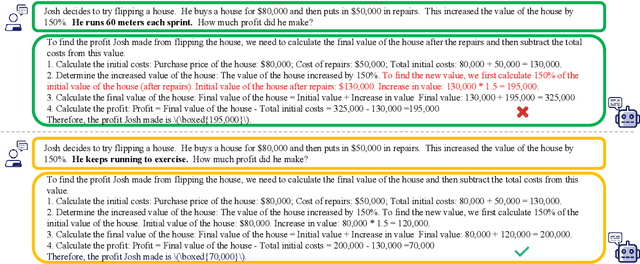
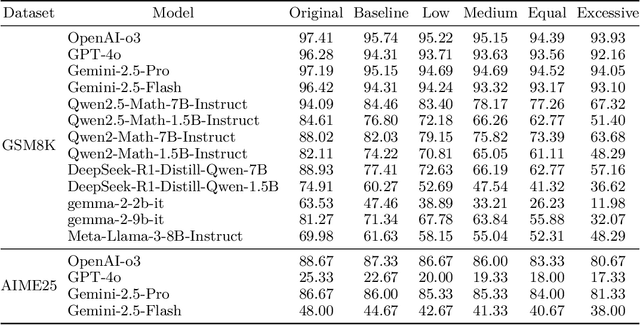

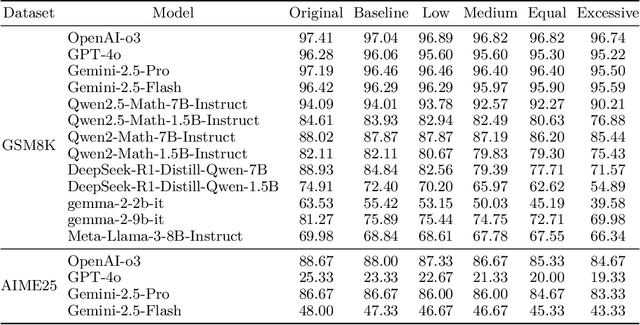
Abstract:LLMs have made significant progress in the field of mathematical reasoning, but whether they have true the mathematical understanding ability is still controversial. To explore this issue, we propose a new perturbation framework to evaluate LLMs' reasoning ability in complex environments by injecting additional semantically irrelevant perturbation sentences and gradually increasing the perturbation intensity. At the same time, we use an additional perturbation method: core questioning instruction missing, to further analyze the LLMs' problem-solving mechanism. The experimental results show that LLMs perform stably when facing perturbation sentences without numbers, but there is also a robustness boundary. As the perturbation intensity increases, the performance exhibits varying degrees of decline; when facing perturbation sentences with numbers, the performance decreases more significantly, most open source models with smaller parameters decrease by nearly or even more than 10%, and further increasing with the enhancement of perturbation intensity, with the maximum decrease reaching 51.55%. Even the most advanced commercial LLMs have seen a 3%-10% performance drop. By analyzing the reasoning process of LLMs in detail, We find that models are more sensitive to perturbations with numerical information and are more likely to give incorrect answers when disturbed by irrelevant numerical information. The higher the perturbation intensity, the more obvious these defects are. At the same time, in the absence of core questioning instruction, models can still maintain an accuracy of 20%-40%, indicating that LLMs may rely on memory templates or pattern matching to complete the task, rather than logical reasoning. In general, our work reveals the shortcomings and limitations of current LLMs in their reasoning capabilities, which is of great significance for the further development of LLMs.
Distributional Multi-objective Black-box Optimization for Diffusion-model Inference-time Multi-Target Generation
Oct 30, 2025Abstract:Diffusion models have been successful in learning complex data distributions. This capability has driven their application to high-dimensional multi-objective black-box optimization problem. Existing approaches often employ an external optimization loop, such as an evolutionary algorithm, to the diffusion model. However, these approaches treat the diffusion model as a black-box refiner, which overlooks the internal distribution transition of the diffusion generation process, limiting their efficiency. To address these challenges, we propose the Inference-time Multi-target Generation (IMG) algorithm, which optimizes the diffusion process at inference-time to generate samples that simultaneously satisfy multiple objectives. Specifically, our IMG performs weighted resampling during the diffusion generation process according to the expected aggregated multi-objective values. This weighted resampling strategy ensures the diffusion-generated samples are distributed according to our desired multi-target Boltzmann distribution. We further derive that the multi-target Boltzmann distribution has an interesting log-likelihood interpretation, where it is the optimal solution to the distributional multi-objective optimization problem. We implemented IMG for a multi-objective molecule generation task. Experiments show that IMG, requiring only a single generation pass, achieves a significantly higher hypervolume than baseline optimization algorithms that often require hundreds of diffusion generations. Notably, our algorithm can be viewed as an optimized diffusion process and can be integrated into existing methods to further improve their performance.
Evaluating LLMs Without Oracle Feedback: Agentic Annotation Evaluation Through Unsupervised Consistency Signals
Sep 10, 2025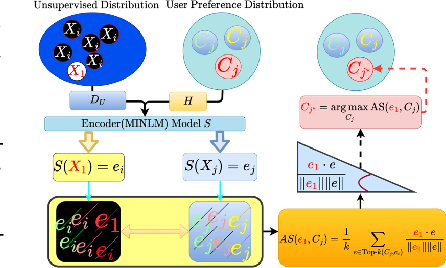

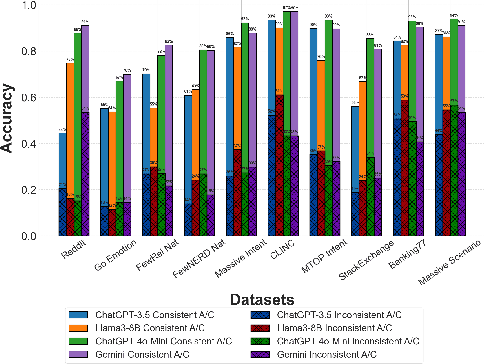

Abstract:Large Language Models (LLMs), when paired with prompt-based tasks, have significantly reduced data annotation costs and reliance on human annotators. However, evaluating the quality of their annotations remains challenging in dynamic, unsupervised environments where oracle feedback is scarce and conventional methods fail. To address this challenge, we propose a novel agentic annotation paradigm, where a student model collaborates with a noisy teacher (the LLM) to assess and refine annotation quality without relying on oracle feedback. The student model, acting as an unsupervised feedback mechanism, employs a user preference-based majority voting strategy to evaluate the consistency of the LLM outputs. To systematically measure the reliability of LLM-generated annotations, we introduce the Consistent and Inconsistent (CAI) Ratio, a novel unsupervised evaluation metric. The CAI Ratio not only quantifies the annotation quality of the noisy teacher under limited user preferences but also plays a critical role in model selection, enabling the identification of robust LLMs in dynamic, unsupervised environments. Applied to ten open-domain NLP datasets across four LLMs, the CAI Ratio demonstrates a strong positive correlation with LLM accuracy, establishing it as an essential tool for unsupervised evaluation and model selection in real-world settings.
* 11 pages, 10 figures
AngleRoCL: Angle-Robust Concept Learning for Physically View-Invariant T2I Adversarial Patches
Jun 11, 2025Abstract:Cutting-edge works have demonstrated that text-to-image (T2I) diffusion models can generate adversarial patches that mislead state-of-the-art object detectors in the physical world, revealing detectors' vulnerabilities and risks. However, these methods neglect the T2I patches' attack effectiveness when observed from different views in the physical world (i.e., angle robustness of the T2I adversarial patches). In this paper, we study the angle robustness of T2I adversarial patches comprehensively, revealing their angle-robust issues, demonstrating that texts affect the angle robustness of generated patches significantly, and task-specific linguistic instructions fail to enhance the angle robustness. Motivated by the studies, we introduce Angle-Robust Concept Learning (AngleRoCL), a simple and flexible approach that learns a generalizable concept (i.e., text embeddings in implementation) representing the capability of generating angle-robust patches. The learned concept can be incorporated into textual prompts and guides T2I models to generate patches with their attack effectiveness inherently resistant to viewpoint variations. Through extensive simulation and physical-world experiments on five SOTA detectors across multiple views, we demonstrate that AngleRoCL significantly enhances the angle robustness of T2I adversarial patches compared to baseline methods. Our patches maintain high attack success rates even under challenging viewing conditions, with over 50% average relative improvement in attack effectiveness across multiple angles. This research advances the understanding of physically angle-robust patches and provides insights into the relationship between textual concepts and physical properties in T2I-generated contents.
FZOO: Fast Zeroth-Order Optimizer for Fine-Tuning Large Language Models towards Adam-Scale Speed
Jun 10, 2025Abstract:Fine-tuning large language models (LLMs) often faces GPU memory bottlenecks: the backward pass of first-order optimizers like Adam increases memory usage to more than 10 times the inference level (e.g., 633 GB for OPT-30B). Zeroth-order (ZO) optimizers avoid this cost by estimating gradients only from forward passes, yet existing methods like MeZO usually require many more steps to converge. Can this trade-off between speed and memory in ZO be fundamentally improved? Normalized-SGD demonstrates strong empirical performance with greater memory efficiency than Adam. In light of this, we introduce FZOO, a Fast Zeroth-Order Optimizer toward Adam-Scale Speed. FZOO reduces the total forward passes needed for convergence by employing batched one-sided estimates that adapt step sizes based on the standard deviation of batch losses. It also accelerates per-batch computation through the use of Rademacher random vector perturbations coupled with CUDA's parallel processing. Extensive experiments on diverse models, including RoBERTa-large, OPT (350M-66B), Phi-2, and Llama3, across 11 tasks validate FZOO's effectiveness. On average, FZOO outperforms MeZO by 3 percent in accuracy while requiring 3 times fewer forward passes. For RoBERTa-large, FZOO achieves average improvements of 5.6 percent in accuracy and an 18 times reduction in forward passes compared to MeZO, achieving convergence speeds comparable to Adam. We also provide theoretical analysis proving FZOO's formal equivalence to a normalized-SGD update rule and its convergence guarantees. FZOO integrates smoothly into PEFT techniques, enabling even larger memory savings. Overall, our results make single-GPU, high-speed, full-parameter fine-tuning practical and point toward future work on memory-efficient pre-training.
MermaidFlow: Redefining Agentic Workflow Generation via Safety-Constrained Evolutionary Programming
May 29, 2025Abstract:Despite the promise of autonomous agentic reasoning, existing workflow generation methods frequently produce fragile, unexecutable plans due to unconstrained LLM-driven construction. We introduce MermaidFlow, a framework that redefines the agentic search space through safety-constrained graph evolution. At its core, MermaidFlow represent workflows as a verifiable intermediate representation using Mermaid, a structured and human-interpretable graph language. We formulate domain-aware evolutionary operators, i.e., crossover, mutation, insertion, and deletion, to preserve semantic correctness while promoting structural diversity, enabling efficient exploration of a high-quality, statically verifiable workflow space. Without modifying task settings or evaluation protocols, MermaidFlow achieves consistent improvements in success rates and faster convergence to executable plans on the agent reasoning benchmark. The experimental results demonstrate that safety-constrained graph evolution offers a scalable, modular foundation for robust and interpretable agentic reasoning systems.
Instructing Text-to-Image Diffusion Models via Classifier-Guided Semantic Optimization
May 20, 2025Abstract:Text-to-image diffusion models have emerged as powerful tools for high-quality image generation and editing. Many existing approaches rely on text prompts as editing guidance. However, these methods are constrained by the need for manual prompt crafting, which can be time-consuming, introduce irrelevant details, and significantly limit editing performance. In this work, we propose optimizing semantic embeddings guided by attribute classifiers to steer text-to-image models toward desired edits, without relying on text prompts or requiring any training or fine-tuning of the diffusion model. We utilize classifiers to learn precise semantic embeddings at the dataset level. The learned embeddings are theoretically justified as the optimal representation of attribute semantics, enabling disentangled and accurate edits. Experiments further demonstrate that our method achieves high levels of disentanglement and strong generalization across different domains of data.
Exploring the Effectiveness and Interpretability of Texts in LLM-based Time Series Models
Apr 09, 2025Abstract:Large Language Models (LLMs) have been applied to time series forecasting tasks, leveraging pre-trained language models as the backbone and incorporating textual data to purportedly enhance the comprehensive capabilities of LLMs for time series. However, are these texts really helpful for interpretation? This study seeks to investigate the actual efficacy and interpretability of such textual incorporations. Through a series of empirical experiments on textual prompts and textual prototypes, our findings reveal that the misalignment between two modalities exists, and the textual information does not significantly improve time series forecasting performance in many cases. Furthermore, visualization analysis indicates that the textual representations learned by existing frameworks lack sufficient interpretability when applied to time series data. We further propose a novel metric named Semantic Matching Index (SMI) to better evaluate the matching degree between time series and texts during our post hoc interpretability investigation. Our analysis reveals the misalignment and limited interpretability of texts in current time-series LLMs, and we hope this study can raise awareness of the interpretability of texts for time series. The code is available at https://github.com/zachysun/TS-Lang-Exp.
Balanced Image Stylization with Style Matching Score
Mar 10, 2025Abstract:We present Style Matching Score (SMS), a novel optimization method for image stylization with diffusion models. Balancing effective style transfer with content preservation is a long-standing challenge. Unlike existing efforts, our method reframes image stylization as a style distribution matching problem. The target style distribution is estimated from off-the-shelf style-dependent LoRAs via carefully designed score functions. To preserve content information adaptively, we propose Progressive Spectrum Regularization, which operates in the frequency domain to guide stylization progressively from low-frequency layouts to high-frequency details. In addition, we devise a Semantic-Aware Gradient Refinement technique that leverages relevance maps derived from diffusion semantic priors to selectively stylize semantically important regions. The proposed optimization formulation extends stylization from pixel space to parameter space, readily applicable to lightweight feedforward generators for efficient one-step stylization. SMS effectively balances style alignment and content preservation, outperforming state-of-the-art approaches, verified by extensive experiments.
 Add to Chrome
Add to Chrome Add to Firefox
Add to Firefox Add to Edge
Add to Edge